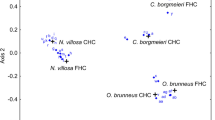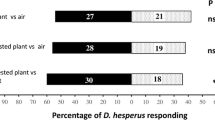Abstract
Essential oils from coniferous trees contain secondary metabolites that act as feeding deterrents for a number of herbivorous mammals. We investigated effects of pine needle oil on feeding and other behaviors of herbivorous plains pocket gophers. In experiment l, pocket gophers were offered sweet potato from single feeding stations placed in home cages of individually housed animals. Stations contained either a scent dispenser with pine needle oil or mineral oil. Subjects removed significantly less food from stations scented with pine needle oil. Experiment 2 was performed to investigate neophobic responses to odors.d-Pulegone, presented under conditions identical to those used in experiment l, did not reduce food removal compared to mineral oil. In experiment 3 pocket gophers were observed in a maze consisting of a start box connected to two goal boxes by tunnels. One goal was scented with pine needle oil, the second with mineral oil. Subjects entered goals scented with pine needle oil significantly less frequently than goals scented with mineral oil and spent less time there. They performed all recorded behaviors at lower frequencies while located in pine-scented goals. In experiment 4 animals were introduced into a maze consisting of a start box from which two soil-packed tunnels could be entered. Embedded in the soil of one tunnel was a barrier of electrical cable that had been soaked in pine needle oil, the second tunnel contained a barrier of cable soaked in mineral oil. Pocket gophers gnawed significantly less insulation from cable treated with pine needle oil than from cable treated with mineral oil. Our results show that constituents in pine needle oil are aversive to plains pocket gophers. Under natural conditions they may function as feeding deterrents. Some of the compounds may be suitable repellents for control of pocket gopher damage.
Similar content being viewed by others
References
Altmann, S. A., andWagner, S. S. 1970. Estimating rates of behavior from Hansen frequencies.Primates 2:181–183.
Behrend, A. F., andTester, J. R. 1988. Feeding ecology of the plains pocket gopher in east central Minnesota.Prairie Nat. 20:99–107.
Bell, C. M., andHarestad, A. S. 1987. Efficacy of pine oil as repellent to wildlife.J. Chem. Ecol. 13:1409–1417.
Benedix, J. H., Jr. 1993. Area-restricted search by the plains pocket gopher (Geomys bursarius) in tallgrass prairie habitat.Behav. Ecol. 4:318–324.
Benedix, J. H., Jr. 1994. A predictable pattern of daily activity by the pocket gopherGeomys bursarius.Anim. Behav. 48:501–509.
Bryant, J. P., Wieland, G. D., Reichardt, P. B., Lewis, V. E., andMcCarthy, M. C. 1983. Pinosylvin methyl ether deters snowshoe hare feeding on green alder.Science 222:1023–1025.
Burton, D. H., andBlack, H. C. 1978. Feeding habits of Mazama pocket gophers in south-central Oregon.J. Wildl. Manage. 42:383–390.
Chase, J. D., Howard, W. E., andRoseberry, J. T. 1982. Pocket gophers. Geomydae, pp. 239–255,in J. A. Chapman and G. A. Feldhamer (eds.). Wild Mammals of North America. The Johns Hopkins University Press, Baltimore.
Clausen, T. P., Reichardt, P. B., andBryant, J. P. 1986. Pinosylvin and pinosylvin methyl ether as feeding deterrents in green alder.J. Chem. Ecol. 12:2117–2131.
Elliott, S., andLoudon, A. 1987. Effects of monoterpene odors on food selection by red deer calves (Cervus elaphus).J. Chem. Ecol. 13:1343–1349.
Epple, G., Nolte, D. L., Mason, J. R., Aronov, E., andWager-Pagé, S. 1996. Behavioral responses to pine needle oil in the northern pocket gopher. In J. R. Mason (ed.).Repellents Wildl. Damage Manage. Colorado State University, In press.
Freeland, W. J., andJanzen, D. H. 1974. Strategies in herbivory by mammals: The role of plant secondary compounds.Am. Nat. 108:269–289.
Gottfried, G. J., andPatton, D. R. 1984. Pocket gopher food habits on two disturbed forest sites in central Arizona. USDA, Forst Service Research Paper RM-255. Rocky Mountain Forest and Range Experiment Station, Fort Collins, CO 80526.
Harborne, J. B. 1991. The chemical basis of plant defense, pp. 45–59,in R. T. Palo and C. T. Robbins (eds.). Plant Defenses Against Mammalian Herbivory. CRC Press, Boca Raton, Florida.
Haslam, E. 1988. Plant polyphenols (syn. vegetable tannins) and chemical defense—a reappraisal.J. Chem. Ecol. 14:1789–1805.
Huntly, N., andInouye, R. 1988. Pocket gophers in ecosystems: Patterns and mechanisms.BioScience 38:786–793.
Iason, G. R., andPalo, R. T. 1991. Effects of birch phenolics on a grazing and a browsing mammal: A comparison of hares.J. Chem. Ecol. 17:1733–1743.
Langenheim, J. H. 1994. Higher plant terpenoids: A phytocentric overview of their ecological roles.J. Chem. Ecol. 20:1223–1279.
Luce, D. G., Case, R. M., andStubbendieck, J. 1980. Food habits of the plains pocket gopher on western Nebraska rangeland.J. Range Manage. 33:129–131.
Mason, J. R. 1990. Evaluation ofd-pulegone as an avian repellent.J. Wildl. Manage. 54:130–135.
McArthur, C., Hagerman, A. E., andRobbins, C. T. 1991. Physiological strategies of mammalian herbivores against plant defenses, pp. 103–114,in R. T. Palo and C. T. Robbins (eds.). Plant Defenses against Mammalian Herbivory, CRC Press, Boca Raton, Florida.
Myers, G. T., andVaughan, T. A. 1964. Food habits of the plains pocket gopher in eastern Colorado.J. Mammal. 45:588–598.
Radwan, M. A., Crouch, G. L., Harrington, C. A., andEllis, W. D. 1982. Terpenes of ponderosa pine and feeding preferences by pocket gophers.J. Chem. Ecol. 8:241–253.
Reichardt, P. B., Bryant, J. P., Clausen, T. P., andWieland, G. D. 1984. Defense of winterdormant Alaska paper birch against snowshoe hares.Oecologia 65:58–69.
Reichardt, P. B., Bryant, J. P., Mattes, B. R., Clausen, T. P., Chapin, F. S., III, andMeyer, M. 1990a. Winter chemical defense of Alaska balsam poplar against snowshoe hares.J. Chem. Ecol. 16:1941–1959.
Reichardt, P. B., Bryant, J. P., Anderson, B. J., Phillips, D., Clausen, T. P., Meyer, M., andFrisby, K. 1990b. Germacone defends labrador tea from broswing by snowshoe hares.J. Chem. Ecol. 16:1961–1970.
Roy, J., andBergeron, J.-M. 1990. Role of phenolics of coniferous trees as deterrents against debarking behavior of meadow voles (Microtus pennsylvanicus).J. Chem. Ecol. 16:801–808.
Schwartz, C. C., Regelin, W. L., andNagy, J. G. 1980. Deer preference for juniper forage and volatile oil treated foods.J. Wildl. Manage. 44:114–120.
Sinclair, A. R. E., Jogia, M. K., andAndersen, R. J. 1988. Camphor from juvenile white spruce as an antifeedant for snowshoe hares.J. Chem. Ecol. 14:1505–1514.
Sullivan, T. P., Krebs, J. A., andKluge, H. A. 1987. Survey of mammal damage to tree fruit orchards in the Okanagan Valley of British Columbia.Northwest Sci. 61:23–31.
Sullivan, T. P., Crump, D. R., Wieser, H., andDixon, E. A. 1992. Influence of the plant antifeedant, pinosylvin, on suppression of feeding by snowshoe hares.J. Chem. Ecol. 18:1151–1164.
Sunnerheim, K., Palo, R. T., Theander, O., andKnutsson, P. G. 1988. Chemical defense in birch. Platyphylloside, a phenol fromBetula pendula inhibiting digestibility.J. Chem. Ecol. 14:549–560.
Sunnerheim-Sjoberg, K. 1992. (1S,2R,4S,5S)-Angelicoidenol-2-O-β-d-glucopyranoside—a moose deterrent compound in scots pine (Pinus sylvestris L.).J. Chem. Ecol. 18:2025–2039.
Sunnerheim-Sjoberg, K., andHamalainen, M. 1992. Multivariate study of moose browsing in relation to phenol pattern in pine needles.J. Chem. Ecol. 18:659–672.
Wager-Page, S., Mason, R., Aronov, E., andEpple, G. 1996. The role of sensory cues and feeding context in the mediation of pine needle oil's repellency in prairie voles. In J. R. Mason (ed.).Repellents Wildl. Damage Manage. Colorado State Univ. Press, In press.
Winer, B. J. 1962. Statistical Principles in Experimental Design. McGraw-Hill, New York. 907 pp.
Author information
Authors and Affiliations
Rights and permissions
About this article
Cite this article
Epple, G., Niblick, H., Lewis, S. et al. Pine needle oil causes avoidance behaviors in pocket gopherGeomys bursarius . J Chem Ecol 22, 1013–1025 (1996). https://doi.org/10.1007/BF02029951
Received:
Accepted:
Issue Date:
DOI: https://doi.org/10.1007/BF02029951




